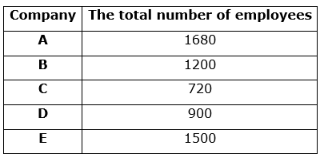Solutions
Let the percentage of the total number of employees in company E = a%
And the percentage of the total number of employees in all five companies = 100%
a + 28 + 20 + 12 + 15 = 100
a = 100 – 75
a = 25
The total number of employees in all five companies = 1500 * 100/25 = 6000
The total number of employees in company A = 6000 * 28/100 = 1680
The total number of employees in company B = 6000 * 20/100 = 1200
The total number of employees in company C = 6000 * 12/100 = 720
The total number of employees in company D = 6000 * 15/100 = 900
The total number of employees in company E = 1500

The number of full time employees in company B = (1200 + 240)/2 = 1440/2 = 720
The number of part time employees in company B = 1200 – 720 = 480
Required ratio = 720:480 = 3:2



 Get latest Exam Updates
Get latest Exam Updates 





 ×
×






